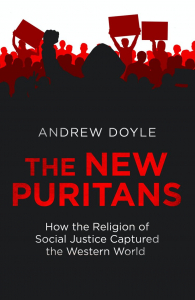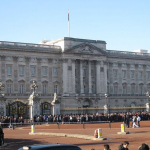Book review: The New Puritans: How the Religion of Social Justice Captured the Western World
In his excellent book, The New Puritans, Andrew Doyle makes the case for why The Crucible might be a better metaphor for today’s identity politics than Nineteen Eighty-Four. It’s a good point. But recent news of the 77th Brigade spying on critics of the government’s lockdown policies shows how a culture that is at ease with Salem-type self-censoring and public denunciations is also one where the state can extend its reach more easily into areas of private and public life where it has no place in a democracy. In his review, Graeme Kemp applauds the detailed and elegant polemic for freedom that is The New Puritans.
In an age when the heated frenzy of the ‘culture wars’ ignites passions – and provokes denials that it even exists – Andrew Doyle issues a detailed polemic in favour of critical thinking, free speech, liberal values and rationality. The New Puritans is one of the more literary and well-argued books to emerge in our pessimistic, postmodern times; it’s a thoughtful introduction and explanation of the ideas behind the so-called culture wars – and their relevance to race and ethnicity. Doyle highlights the danger he says we face:
Those of us who recognise that we beneficiaries of the Enlightenment have been troubled by the rise of a movement…that is impervious to reason and regards the marketplace of ideas with suspicion. (Page 4).
Pessimism and Cynicism
The movement that has been so successful in recent years has sometimes been described as ‘woke’ – but usually includes the specific ideas of Critical Race Theory (CRT), for example. If anyone lacks familiarity with these previously obscure ideas, Doyle provides the background useful to understanding what’s going on.
Critical theory is the child of postmodern and post-structuralist ideas that germinated in the 1960s, flourished in the universities, and now dominate all aspects of the state. This near-religious belief system includes ideas hostile to concepts such as colour-blind anti-racism , on ideological grounds. Its supporters are the ‘New Puritans’ according to Doyle. Pessimism and cynicism about progress are characteristic of a new divisive way of looking at humanity and its capabilities. His analysis of current political and social trends is more than simply a list of ‘political correctness gone mad’ stories that we may be familiar with, it is a rallying cry for Enlightenment values he now sees as seriously in danger.
So, why do ‘woke’ ideas pose such a threat, according to Doyle?
Doyle explains the danger posed by ideas such as Critical Race Theory – which is more than simply opposition to racism. CRT works on the following assumption: ‘race’ is the defining element of Western societies – and something called ‘whiteness’ defines the power structures of those Western societies. Racism is institutional, structural and systemic and is present in all conceivable situations and in relations between different racial groups. Just in case we thought things were improving for ethnic minorities in the West, Doyle notes:
Critical Race Theory thereby offers us an alternative vision of society, one that is pessimistic, regressive and opposed to material reality. It asks us to believe that racism is normalised and predominant, even though studies show that the vast majority of people in Britain are opposed to any form of racial prejudice. It suggests that the progress made since the civil rights movements of the 1960s is a mirage, that racism has been subsumed into all strata of society… (Page 189)
‘Fortunately’, thinkers such as Ibram X Kendi – and The Guardian – are adept at spotting just how racist society still is though. Other writers such as Robin DiAngelo claim that if anyone argues against the idea that racism permeates all aspects of our lives – and defines human interactions – that simply proves how successful racism is in colonising our minds. And ‘lived experience’ can back this up; ‘white fragility’ is all too real.
Rejection of universal values
Now, Doyle is quite honest – there are still some racists around. And racism can be real. However, Critical Race Theory sees racism manifesting itself everywhere. Most CRT thinkers argue that the problem is bigger than just a relatively small number of bigots or extremist political parties. ‘Whiteness’ is the real threat, it seems. Doyle quotes DiAngelo on what this means:
“Whiteness rests on a foundational premise: the definition of whites as the norm or standard …Whiteness is not acknowledged by white people, and the white reference point is assumed to be universal and imposed on everyone.” (page 195).
This is where we should get suspicious, argues Doyle – CRT portrays universal, objective standards, arguments or evidence as merely the product of the so-called ‘white’, Western, privileged mind, not the human or universal consciousness. CRT maintains a counter-Enlightenment stance. And yet, this paranoid theory is gaining ground in the state, including universities and schools, as well as media and culture. CRT rehabilitates racial thinking – and as Doyle points out,that’s actually no way to oppose racism.
Doyle develops his analysis by explaining how these ‘woke’ theories above try to control our sense of reality by controlling language itself – the essence of the society depicted in George Orwell’s novel Nineteen Eighty-Four. Doyle is clear – language is being corrupted for ideological ends – and dissent crushed.
Interestingly, Doyle’s love of literature and art shines through in The New Puritans amid the politics and the controversies of critical theory. Indeed, one of the most interesting and different chapters is entitled ‘Transcendence’. It has a fascinating opening description of ancient rocks emerging from the sea off Sark, in the Channel Islands, before moving to a description of an oil painting by Charles Temple Dix (1838-73) in the Guernsey Museum featuring a raging storm and shipwreck. Doyle then links the dramatic landscape to key scenes in ‘Toilers of the Sea’ (1866) by Victor Hugo. The reason for all this – apart from a break away from the culture wars raging elsewhere? Doyle answers:
“Cultural conservatives are right to emphasise the significance of our relationship to the past. Certain aspects of postmodernism have had a degrading effect on humanity, concerned as they are with the demolition of grand narratives and a reduction of human experience to a transactional relationship to power and language.” (Page 242).
Doyle then reflects on canonical works of art in painting and literature, pointing out how their individual, creative geniuses raged against forced conformity. The collectivist, cynical attitudes of the Critical Social Justice movement, Doyle says, clash with these writers’ humane, artistic values. As he points out: “Art and literature are natural targets for the new puritans.” (Page 243) The Western canon is threatened by the demolition wrecking ball of the new puritans – not least if the authors are straight, white and male. Art and literature, argues Doyle, must be defended against the CSJ philistines and their obsessions with power and deconstruction – of both texts and society. We cannot be complacent.
One of the strengths of Doyle’s book is to assert, as good, what CRT and gender ideologists fear most: free speech, open debate and liberal values. As he points out: “To uphold liberal values has become a risky endeavour…” (Page 298). These ‘Western’ (but actually universal) values do matter because they have delivered real, positive results in the past for sexual and ethnic minorities, as well as wider society. There was progress in the past; postmodern pessimists are simply wrong. We need more Enlightenment, today, not less.
What to do?
The book ends with some great suggestions, such as the greater use of critical thinking tools in school lessons, so young people have the ability to think for themselves and evaluate claims. Students must gain detailed, subject-specific knowledge, too. We also need a genuine culture of free debate – and less taking offence. Satire and comedy should not be sanitised.
As with the accusations levelled against so-called ‘witches’ at the Salem witch trials, we need to eventually just stand up and say ‘no’ to unfounded, irrational and illiberal ideas. We cannot allow society to be divided and segregated again according to race, gender or sexuality. As Andrew Doyle says:
“We should reclaim the courage to think for ourselves, as encapsulated in Horace’s phrase sapere aude – ‘dare to know’ – which Kant appropriated as the motto of the Enlightenment. The desire for a quiet life is entirely understandable, but we have surely reached the point where the keys of the kingdom must be wrenched back from the hands of the crazy children.” (Page 305).
There is a war to be won. Andrew Doyle’s book provides a clear introduction to these issues affecting modern society and why these issues matter.
Graeme Kemp is a former civil servant and teacher who has worked in different roles in education from the south-coast of England to Scotland. As well as ‘Don’t Divide Us’ he has contributed reviews to the ‘Equiano Project’. He is proud to currently live in the Midlands.
The New Puritans: How the Religion of Social Justice Captured the Western World by Andrew Doyle was published in 2022 by Constable (London).


